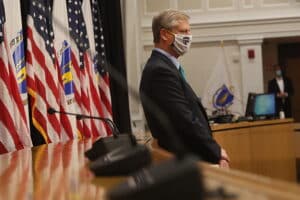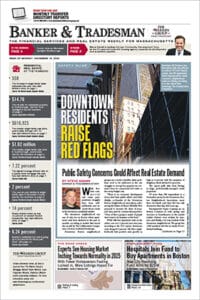
Gov. Charlie Baker listens as Marylou Sudders, Secretary of Health and Human Services speaks during a media briefing on Oct. 27, 2020. Photo by Suzanne Kreiter | Globe Staff/Pool
Editor’s Note: Gov. Charlie Baker has announced new restrictions on businesses, private gatherings and an order governing the wearing of masks in public.
After a weekend that saw the number of COVID-19 deaths surpass 10,000 and as the number of people who need hospital care for a coronavirus infection rises, Gov. Charlie Baker will announce new orders related to the state’s economic reopening on Monday afternoon.
The governor’s office said he, Lt. Gov. Karyn Polito and Health and Human Services Secretary Marylou Sudders will detail “new executive orders affecting the reopening process due to recent increases in new cases and hospitalizations of COVID-19 across the state” at a 1:30 p.m. press conference Monday.
There were 2,431 new cases of COVID-19 confirmed in Massachusetts over the weekend, 10,013 people with confirmed or probable cases of the virus have died here since mid-March, and the autumn resurgence of the virus appears to be underway. The state has reported more than 1,000 new cases of COVID-19 each day for more than a week.
Baker’s press conference will be livestreamed from the State House shortly after 1:30 p.m.
On Friday, Rhode Island Gov. Gina Raimondo announced that she was cutting her state’s gathering limit from 15 to 10 people, prohibiting spectators at youth sporting events for the next two weeks, curtailing visits at hospitals and nursing homes, and closing indoor athletic facilities for one week. She said Rhode Island was “on a path” to opening a field hospital in the next few weeks, according to WPRI.
The overwhelming majority of COVID-19 cases that state public health officials linked to cluster outbreaks occurred at home rather than in schools, child care, or restaurants, according to data published Thursday.
Between Sept. 27 and Oct. 24, the Department of Public Health identified 2,945 new clusters – where two or more infections stemmed from a common outbreak – representing 8,208 confirmed cases of the highly infectious coronavirus.
More than 83 percent of those were deemed to be household exposure, meaning the transmission likely occurred between people who live at the same address and were not linked to a different type of cluster. Another roughly 7 percent of cluster cases were in long-term care facilities.
None of the other 21 setting categories – including K-12 schools, restaurants and food courts, and retail and services – represented even 2 percent of the total confirmed cluster infections over the roughly one-month span, though their shares could increase if close contacts to those who contracted the virus in turn fall ill.






